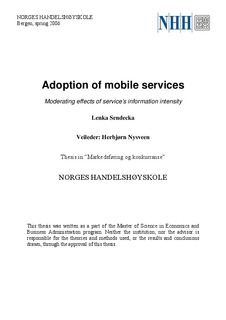Adoption of mobile services : moderating effects of service’s information intensity
Master thesis

Åpne
Permanent lenke
http://hdl.handle.net/11250/167783Utgivelsesdato
2006-05-16Metadata
Vis full innførselSamlinger
- Master Thesis [4372]
Sammendrag
The increased use of mobile technology has been dramatic in the recent years. Understanding some of the reasons for this immense expansion lies in comprehending the factors behind consumer usage patterns. Hence it is becoming more and more crucial for today’s marketers to study how and why consumers adopt (new) technology and mobile services. The knowledge of adoption process and the factors driving it may be relevant for both providers and customers. Several models for adoption of information technology or mobile services, in particular, have been developed. However, the combination of some of these models has not been studied yet. Therefore, first objective in this paper was to study the combination of some of these models, namely combined model of Nysveen, Pedersen & Thorbjørnsen (2005a) with a variable (compatibility) from Rogers’ (1983) model. Secondly, there are still some unexplored dimensions related to the understanding of consumers’ intentions to use mobile services, especially when it comes to the effect of moderating variables on the intention to use mobile services. Therefore, the examination of the effect of a moderating variable was the second objective in this paper as it enables a more nuanced understanding of motives for use of mobile services. And since information intensity is a service characteristic that has been researched very little, it was the one whose moderating effect was measured in the paper. Thirdly, throughout the paper it became clear that a new scale for measuring information intensity was needed, and thus the composition of the scale become the third objective and theoretical contribution of this paper. This study builds on the past models deeply rooted in the recognized theories. I have used a set of theories consisting of Fishbein’s multiattribute model, Theory of Reasoned Action, Theory of Planned Behaviour, Technology Acceptance Model, Innovation Diffusion Theory and some studies on the adoption of mobile services, such as Nysveen, Pedersen & Thorbjørnsen (2005a), Nysveen, Pedersen & Thorbjørnsen (2005b), Lexhagen, Nysveen & Hem (2005), Hung, Ku & Chang (2003) and Teo & Pok (2003). The model in this paper proposed several direct effects and moderating effects of information intensity between the drivers of adoption and the consumers’ intention to use mobile service, which were tested through two phased- method. In the first one, a pre-test was carried out in order to find the information intensity of the particular mobile services. The scale for measurement was developed and tested. Once this was done, two services, one with high and one with low information intensity were selected for further study. The main research was then carried out in the second phase in order to test the effects between the variables. Regression analysis was used to analyse the result from the questionnaire. The results showed that when compatibility was added to the combined model, the model’s explanatory power increased. Thus, combining the model with a variable from another model was successful, and objective one was met. As to the second objective, it has been shown that the degree of information intensity moderated some of these relationships, namely the relationship between perceived enjoyment and intention to use mobile services, perceived expressiveness and intention to use mobile services and perceived behavioural control and intention to use mobile services. The results of this research have both theoretical and practical implications for the future research or for the marketers. Limitations of the study can be addressed and solved in the consecutive studies.